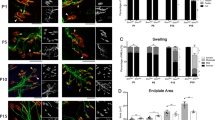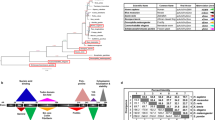Abstract
Spinal muscular atrophy (SMA) is a motor neuron disease characterized by degeneration of the anterior horn cells of the spinal cord. It is a common fatal autosomal recessive disorder and linkage studies have identified two candidate genes, SMN (ref. 1) and NAIP (ref. 2), both on chromosome 5q13. Although NAIP protein is known to have an anti-apoptotic function3, the function of SMN has been unclear and it shows no significant sequence similarity to any other protein. The SMN gene is deleted or interrupted on both chromosomes in nearly all SMA patients1. Here we show that SMN interacts with Bcl-2, another anti-apoptotic protein4, and that co-expression of SMN with Bcl-2 confers a synergistic preventive effect against Bax-induced or Fas-mediated apoptosis, although SMN itself has only a weak anti-apoptotic activity. SMNY272C, which carries a missense mutation and was found in an SMA patient who exceptionally retained SMN on one allele1, exerts no synergism with Bcl-2. Furthermore, the product of a truncated transcript lacking exon 7, which was derived from an SMN gene carrying an intragenic mutation or from the SMN copy gene c BCD541 (ref. 1) retained in all SMA patients, had no synergistic activity but instead had a dominant-negative effect on full-length SMN. Our results indicate that an absent or decreased anti-apoptotic activity of SMN in concert with Bcl-2 underlies the pathogenesis of SMA.
This is a preview of subscription content, access via your institution
Access options
Subscribe to this journal
Receive 51 print issues and online access
$199.00 per year
only $3.90 per issue
Buy this article
- Purchase on Springer Link
- Instant access to full article PDF
Prices may be subject to local taxes which are calculated during checkout




Similar content being viewed by others
References
Lefebvre, S. et al . Identification and characterization of a spinal muscular atrophy-determining gene. Cell 80, 155–165 (1995).
Roy, N. et al . The gene for neuronal apoptosis inhibitory protein is partially deleted in individuals with spinal muscular atrophy. Cell 80, 167–178 (1995).
Liston, P. et al . Suppression of apoptosis in mammalian cells by NAIP and a related family of IAP genes. Nature 379, 349–353 (1996).
Gajewski, T. F. & Thompson, C. B. Apoptosis meets signal transduction: elimination of a BAD influence. Cell 87, 589–592 (1996).
Yang, E. et al . Bad, a heterodimeric partner for Bcl-xLand Bcl-2, displaces Bax and promotes cell death. Cell 80, 285–291 (1995).
Liu, Q. & Dreyfuss, G. Anovel nuclear structure containing the survival of motor neuron proteins. EMBO J. 15, 3555–3565 (1996).
Krajewski, S. et al . Investigation of the subcellular distribution of the bcl-2 oncoprotein: residence in the nuclear envelope, endoplasmic reticulum, and outer mitochondrial membranes. Cancer Res. 53, 4701–4714 (1993).
Akao, Y., Otsuki, Y., Kataoka, S., Itoh, Y. & Tsujimoto, Y. Multiple subcellular localization of bcl-2: detection in nuclear outer membrane, endoplasmic reticulum membrane, and mitochondrial membranes. Cancer Res. 54, 2468–2471 (1994).
Deckwerth, T. L. et al . Bax is required for neuronal death after trophic factor deprivation and during development. Neuron 17, 401–411 (1996).
Bussaglia, E. et al . Aframeshift deletion in the survival motor neurons gene in Spanish spinal muscular atrophy patients. Nature Genet. 11, 335–337 (1995).
Gennarelli, M. et al . Survival motor neurons gene transcript analysis in muscles from spinal muscular atrophy patients. Biochem. Biophys. Res. Commun. 213, 342–348 (1995).
Eguchi, Y., Ewert, D. L. & Tsujimoto, Y. Isolation and characterization of the chicken bcl-2 gene: expression in a variety of tissues including lymphoid and neuronal organs in adult and embryo. Nucleic Acids Res. 20, 4187–4192 (1992).
Muchmore, S. W. et al . X-ray and NMR structure of human Bcl-xL, an inhibitor of programmed cell death. Nature 381, 335–341 (1996).
Chang, B. S., Minn, A. J., Muchmore, S. W., Fesik, S. W. & Thompson, C. B. Identification of a novel regulatory domain in Bcl-xLand Bcl-2. EMBO J. 16, 968–977 (1997).
Burlet, P. et al . Large scale deletions of the 5q13 region are specific to Werdnig-Hoffmann disease. J. Med. Genet. 33, 281–283 (1996).
Michaelidis, T. M. et al . Inactivation of bcl-2 results in progressive degeneration of motoneurons, sympathetic and sensory neurons during early postnatal development. Neuron 17, 75–89 (1996).
Merry, D. E., Veis, D. J., Hickey, W. F. & Korsmeyer, S. J. Bcl-2 protein expression is widespread in the developing nervous system and retained in the adult PNS. Development 120, 301–311 (1994).
Acknowledgements
We thank J. Miyazaki, A. Shinohara and D. Y. Mason for their kind gifts of pCAGGS-BMG plasmid, pBTM116-RAD51 and anti-hBcl-2 mAb, respectively; T. Hachiya and M. Ikeda for their help in generating antibodies; and M. Hoffman for editorial assistance. This work was supported in part by grants for Scientific Research on Priority Areas and for COE Research from the Ministry of Education, Science, and Culture of Japan.
Author information
Authors and Affiliations
Corresponding author
Rights and permissions
About this article
Cite this article
Iwahashi, H., Eguchi, Y., Yasuhara, N. et al. Synergistic anti-apoptotic activity between Bcl-2 and SMN implicated in spinal muscular atrophy. Nature 390, 413–417 (1997). https://doi.org/10.1038/37144
Received:
Accepted:
Issue Date:
DOI: https://doi.org/10.1038/37144
This article is cited by
-
Revisiting the role of mitochondria in spinal muscular atrophy
Cellular and Molecular Life Sciences (2021)
-
Protective Effect of Saccharomyces boulardii on Deoxynivalenol-Induced Injury of Porcine Macrophage via Attenuating p38 MAPK Signal Pathway
Applied Biochemistry and Biotechnology (2017)
-
Severe impairment of male reproductive organ development in a low SMN expressing mouse model of spinal muscular atrophy
Scientific Reports (2016)
-
Nanomolar Naloxone Attenuates Neurotoxicity Induced by Oxidative Stress and Survival Motor Neuron Protein Deficiency
Neurotoxicity Research (2014)
-
Spinal Muscular Atrophy and the Antiapoptotic Role of Survival of Motor Neuron (SMN) Protein
Molecular Neurobiology (2013)
Comments
By submitting a comment you agree to abide by our Terms and Community Guidelines. If you find something abusive or that does not comply with our terms or guidelines please flag it as inappropriate.



